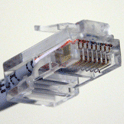
Industrial Ethernet networks can save on wiring
Wiring displacement remains a primary driver for traditional serial device networks, which rely less on commercial off-the-shelf (COTS)-based IT technology than other network types. However the compelling wiring savings delivered by traditional serial device networks is increasingly overshadowed in some quarters by the growing movement toward a single network technology, typically Ethernet, throughout the plant or enterprise, says the study.
Industrial Ethernet’s standard hub-and-spoke topology offsets any potential for wiring savings, but its rising popularity in spite of this shortcoming is indicative of
the importance of integration with higher-level enterprise systems. Wireless networks, however, represent new ground for FA networks in areas such as mobility and remote access. Continued introduction of ruggedized remote I/O, sensors, actuators, infrastructure, and other devices will further adoption of factory automation networks over the next five years, says the report.
Discrete manufacturing industries were some of the hardest hit by the recent global recession. FA networks continue to provide a significant value proposition in their served markets, however, and the market for potentially attached devices remains unsaturated.
For more information visit ARC Advisory Group.